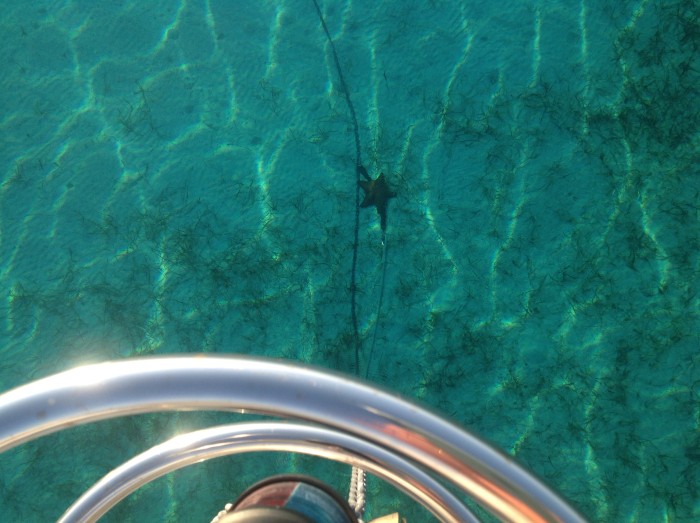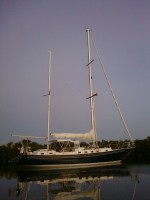
S.V. Gratitude
Brewer 44, hull number 284
18 March 2019 | Cumberland Island, GA
08 February 2019
08 February 2019 | George Town, Exumas
01 February 2019 | Great Harbor Cay
31 December 2018 | Stuart, FL
21 December 2018 | Stuart Florida
21 December 2018
17 December 2018 | Stuart, FL
14 December 2018 | St. Augustine, FL
13 December 2018 | Sister’s Creek
12 December 2018 | Atlantic Ocean
11 December 2018 | Windmill Harbour
01 March 2017 | Exumas
26 February 2017 | Jumentos Cays & Ragged Islands
09 February 2017 | Hog Cay, Jumentos Islands, Bahamas
27 January 2017 | En Route to Nassau
23 January 2017 | Sister Creek, Marathon, FL
06 January 2017 | Cayo Costa State Park
17 March 2016
14 March 2016
Stars
09 February 2017 | Hog Cay, Jumentos Islands, Bahamas
EVS: Incredible

Stars are very important when aboard a boat. We take our bearings from them, we navigate by them, we marvel at them during night crossings or at anchor. One does not really appreciate how many exist or how beautiful they are until one is away from land (or at least populated areas) and lights. On a dark night, with no moon and no other lights, starlight can enable one to discern the surface of the water and sea conditions and provide assurance that the world (or at least the water) is where it is supposed to be.
Constellations have guided navigators for centuries. The Big Dipper points to Polaris, the north star, the Southern Cross (if one is in the Southern Hemisphere) points to the South Pole, as does Orion’s Belt in the Northern Hemisphere. Myriad other constellations and star groupings have guided people across the vast oceans since time immemorial. We do not use stars to our advantage in that sense – we rely on Global Positioning Satellites (GPS) to tell us where we are within feet of our actual position. That, combined with radar and Automated Identification System (AIS), tells us about the location, direction, and speed of nearby vessels thereby keeping us informed and safe as we travel.
But other stars provide other benefits. Take the star fish at our anchor in 10 feet of water. We felt safe and secure knowing that the star in the photograph was keeping an eye (or at least an arm) on us and our connection to the sea bed. Here in the Jumentos we have seen literally dozens, if not hundreds of star fish of all shapes and sizes, from small (maybe 3” across) along the water’s edge at the beach to others (dinner plate size or larger) and in a variety of colors (red, to rust, to red with yellow veining). We do not know what starfish do or what “purpose” they serve other than to provide us with comfort in knowing where we are, where we are to stay, and how lovely is the environment in which we find ourselves.
Constellations have guided navigators for centuries. The Big Dipper points to Polaris, the north star, the Southern Cross (if one is in the Southern Hemisphere) points to the South Pole, as does Orion’s Belt in the Northern Hemisphere. Myriad other constellations and star groupings have guided people across the vast oceans since time immemorial. We do not use stars to our advantage in that sense – we rely on Global Positioning Satellites (GPS) to tell us where we are within feet of our actual position. That, combined with radar and Automated Identification System (AIS), tells us about the location, direction, and speed of nearby vessels thereby keeping us informed and safe as we travel.
But other stars provide other benefits. Take the star fish at our anchor in 10 feet of water. We felt safe and secure knowing that the star in the photograph was keeping an eye (or at least an arm) on us and our connection to the sea bed. Here in the Jumentos we have seen literally dozens, if not hundreds of star fish of all shapes and sizes, from small (maybe 3” across) along the water’s edge at the beach to others (dinner plate size or larger) and in a variety of colors (red, to rust, to red with yellow veining). We do not know what starfish do or what “purpose” they serve other than to provide us with comfort in knowing where we are, where we are to stay, and how lovely is the environment in which we find ourselves.
Comments
| Vessel Name: | Gratitude |
| Vessel Make/Model: | Brewer 44 Ketch |
| Hailing Port: | Brandon, VT |
| Crew: | Van and Lauren |
| About: | It is hard to believe, but this is our 7th season aboard Gratitude. It will be a short season and close to FL, but we hope to relax, enjoy the time, being on the water, and each other. Come along. |
| Extra: | Live it while you can. |
Gallery not available
2015 Cruise

Who: Van and Lauren
Port: Brandon, VT